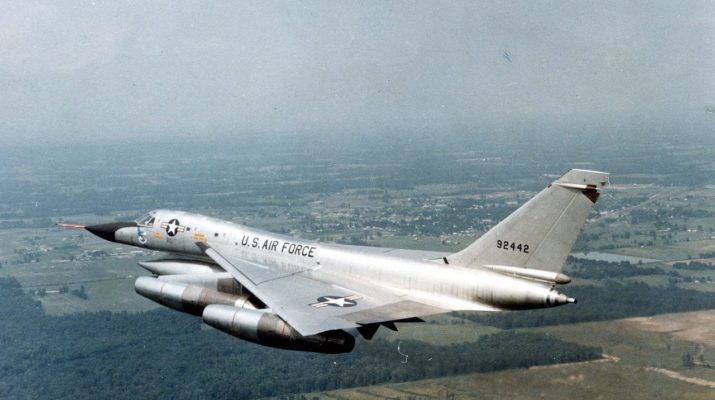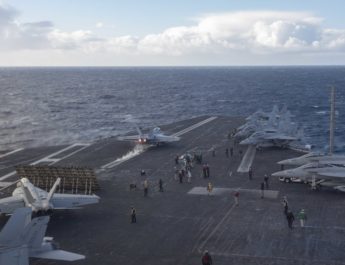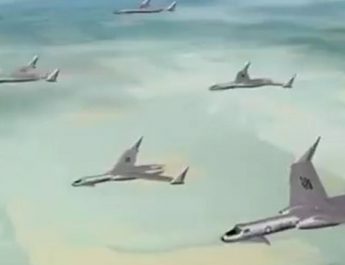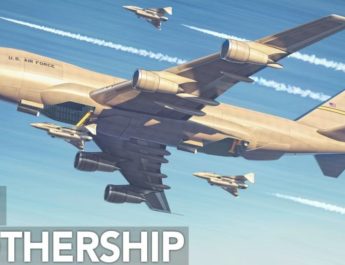On November 11, 1956, the first operational jet bomber B-58 Hustler took flight. It was designed by Convair engineer Robert H. Widmer and developed for United States Air Force. But, it would never see combat.
Introduction was on March 15, 1960. It used a delta wing, with four J79-GE-5A turbojet engines in under wing pods, capable of individually producing 10,400 pounds of dry thrust.
As a supersonic jet bomber Hustler was capable of flying at Mach 2.0, with a maximum altitude of 63,400 feet, much more than B-52 Stratofortress and the Stratojet. It was well suited for low-altitude, high speed flight.
For a bomber, the Hustler was a small aircraft, with its 95.10- foot length and 56.90 – foot-wingspan. This helped to create one of the biggest shortcomings, an unrefueled combat radius of only 1,740 miles.

Owing to heat at Mach 2.0, the B-58 Hustler utilized extensive applications of aluminum honeycomb panels, which bonded aluminum skins to a honeycomb of aluminum or fiberglass. Later, this method would inform future jet aircraft.
Each of the three crew members – pilot, observer (navigator, radar operator, bombardier), defense system operator (DSO; electronic countermeasures operator and pilot assistant), was seated in his own compartment.
The bomber was mechanically complicated and expensive. The total cost of the B-58 program was $3 billion (around $20 billion now). B-58 was difficult to fly, but its performance was exceptional.
The J79 engine ran into problems, as did the braking system and ejection seats, the latter of which Convair swapped out for ejectable pods.

The Convair B-58 Hustler set 19 world speed records, including coast-to-coast records, and the longest supersonic flight in history. In 1963, it flew from Tokyo to London (via Alaska), a distance of 8,028 miles (12,920 km) in 8 hours, 35 minutes, 20.4 seconds, averaging 938 miles per hour (1,510 kilometres per hour). This record still stands.
A total of 116 B-58s were produced. 30 trial aircraft (later upgraded to operational standard. 8 were equipped as TB-58A training aircraft) and 86 production B-58 models.
On January 31, 1970, the Air Force retired the Hustler.
The classic B-58 Hustler film narrated by Brig. General Jimmy Stewart.
B-58A Specifications
- Length: 96 ft 10 in (29.5 m)
- Wingspan: 56 ft 9 in (17.3 m)
- Height: 29 ft 11 in (8.9 m)
- Wing area: 1,542 ft² (143.3 m²)
- Empty weight (OEW): 55,560 lb (25,200 kg)
- Loaded weight: 67,871 lb (30,786 kg)
- Maximum takeoff weight (MTOW): 176,890 lb (80,240 kg)
- Engines: 4 × General Electric J79-GE-5A turbojet. Dry thrust: 10,400 lbf dry thrust (52.9 kN)each; Thrust with afterburner: 15,600 lbf (69.3 kN) each
B-58 Performance
- Maximum speed: Mach 2.0 (1,319mph) at 40,000 ft (12,000 m)
- Cruise speed: 610 mph (530 kn, 985 km/h)
- Combat radius: 1,740 mi (3,220 km)
- Range: 4,700 mi (7,600 km)
- Service ceiling: 63,400 ft (19,300 m)
- Rate of climb: 17,400 ft/min (88 m/s) at gross weight
- Wing loading: 44.0 lb/ft² (215 kg/m²)
- Thrust/weight: 0.919 lbf/lb
- Lift-to-drag ratio: 11.3 (subsonic, “clean configuration”)
B-58 Armament
- Guns: 1× 20 mm T171 cannon
- Bombs: 1× B53 or 4× B43 or B61 nuclear bombs; maximum weapons load was 19,450 lb (8,820 kg)





